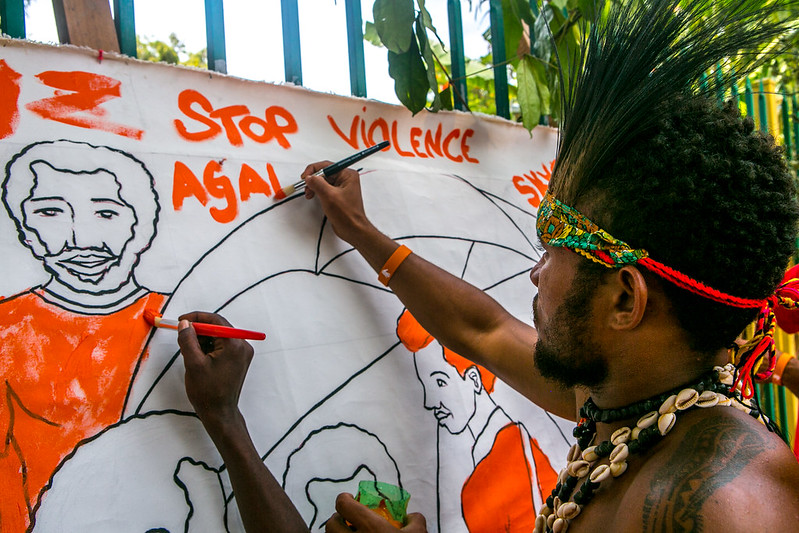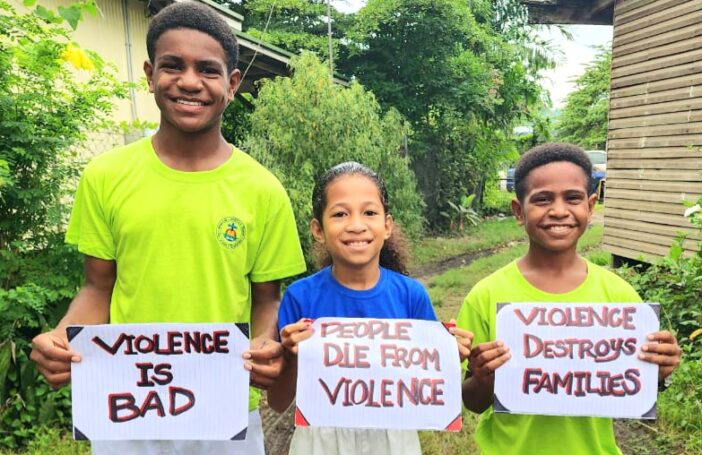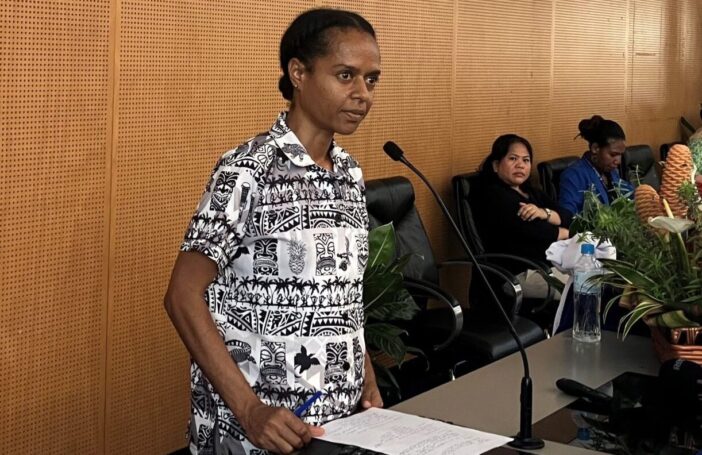According to recent research, Papua New Guinea is one of the three countries in the world with the highest prevalence of lifetime intimate partner violence against women.
This blog examines four common perceptions about spousal violence in PNG using the last PNG Demographic and Health Survey (DHS, 2016-18). Note that the data below is based on answers in relation to the 12 months prior to the survey, and that I follow the DHS in referring to intimate partner violence as spousal violence, since in PNG the great majority of intimate partners are spouses. The violence is either physical or sexual.
The first common perception is that education protects women against spousal violence. Studies, in Bangladesh and Peru for example, have shown that attaining an additional level of education increases women’s household status and reduces their exposure to spousal violence. However, in PNG the opposite is true. Figure 1 shows that the prevalence of spousal violence (average 48%) increases with education level. The prevalence of spousal violence is 18 percentage points higher for women with higher education than women without formal education. Possibly, a wife’s additional education poses a threat to traditional male dominance, provoking men to subjugate women through violence.

Second, poorer women are commonly perceived to be more vulnerable to spousal violence (for example in Myanmar). However, this is not the case in PNG. Figure 2 shows that the prevalence of spousal violence increases with household wealth: 55% of women in the highest wealth quintile experienced spousal violence compared to 44% in the lowest wealth quintile.

Third, women in rural areas are perceived to have higher exposure to spousal violence because rural areas are strongholds of polygyny and bride price practices. And indeed 72% of men in rural areas in PNG agree that wife beating is justifiable compared to 66% in urban centres.
However, the prevalence of spousal violence is in fact nine percentage points higher in urban centres (56%) compared to rural areas (47%). This is consistent with the fact that urban women are more likely to be more educated. The typical urban woman has 8.2 years of education versus 5.3 for the typical rural woman. Urban households are also much wealthier: 71% of urban households are among the nation’s 20% richest, versus only 14% of rural households. Furthermore, there are particular kinds of dynamics and pressures faced in PNG’s urban context that fuel spousal violence.
Finally, the massive difference between men’s and women’s experiences of spousal violence as victims (mostly women) and as perpetrators (mostly men) means that advocacy and policy responses mainly target women. However, the DHS data shows that a considerable number of women in PNG are also perpetrators of spousal violence. On average, 17% of women had perpetrated spousal physical violence in the 12 months of the study, while 44% had been victims.
The DHS reports on the background characteristics of husbands or intimate partners who are victims of spousal violence. Husbands who often drink alcohol or display excessive marital control behaviour are more likely to suffer spousal violence from women. Provinces where women are more likely to be victims are also those in which they are more likely to be perpetrators (Figure 3). This is because most women who commit violence (85%) have also been at the receiving end of it. Only 6% of women who had never experienced physical violence themselves had perpetrated it in the 12 months of the study.

To summarise, spousal violence is endemic across the country. Educated women in richer, urban households are more at risk. Most violence is perpetrated by men. While violence by women is also fairly common, it is nearly entirely by those who are themselves at the receiving end of violence.
There are many implications from this analysis. Above all, spousal violence must be understood within a broader social context. It is important but not enough to say that violence against women must end. Broader issues, such as unemployment and excessive drinking, also need to be addressed to reduce spousal violence in PNG.
Note: Except where otherwise mentioned, the blog uses results from the PNG 2016-18 Demographic and Health Survey. The survey interviewed 3,701 ever-married women aged 15 to 49. The data on violence against women is the share of women who experienced spousal sexual or physical violence committed by their current or most recent partner in the preceding 12 months. The data on violence against men is the share of men who experienced spousal physical violence from their current partner or wife in the preceding 12 months.





Insightful piece, however was looking at analysis of both gender, we know GBV can be perpetrated by both gender, men , women and children.
A positive insight there. The underlying issues of violence in the country needs to be solved by the government. Violence is broad, the cause has to be addressed by the authorities, by then the epidemic be minised. Thanks for the information Mr Kingtau.
Interesting analysis, but a possible counter argument: Women with higher levels of education are more aware of what intimate partner violence looks like and that is something that should be eradicated, therefore they are more likely to recognise it, recognise they have experienced it, and acknowledge it when asked. They may also feel braver/more socially confident to express that they have experienced it, compared to women with lower levels of education who may think that IPV is something ‘normal’.
Thanks Kate for bringing this up.
DHS survey collects data on all types of spousal violence; physical, sexual and emotional violence. The blog only use physical and sexual violence as both educated and uneducated women are more likely to recognise and report them.
I think this is plausible and the self-reported nature was my first thought. But the little evidence I could find after a brief look around suggests the opposite: more educated women being less likely to report for a given level of prevalence, suggesting these differences may be more likely to be attenuated than overestimated. Check out this very interesting write-up of an interesting approach used in Peru:
https://blogs.iadb.org/ideas-matter/en/can-domestic-violence-be-accurately-measured/
Relatedly, this study documents the same effect implicit in Kingtau’s blog except holding attitudes, which I would expect to be a mediator of reporting, and other things constant, and education shifting as good as randomly to help isolate its effect.
https://www.jstor.org/stable/26528370
A very sound analysis of what the author is writing in the context of everyday living and interactions.
On a more related reason, the introduction of mobile phones and internet has vastly increased external relationships, which also raises suspicions which in turn contributes to spousal abuse. It would be interesting to collate data regarding this factor to further analyse and comment.
Thank you for this research insight on the subject.